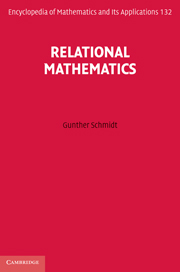Book contents
- Frontmatter
- Contents
- Notes on illustrations
- Preface
- 1 Introduction
- PART I REPRESENTATIONS OF RELATIONS
- PART II OPERATIONS AND CONSTRUCTIONS
- PART III ALGEBRA
- PART IV APPLICATIONS
- PART V ADVANCED TOPICS
- 17 Mathematical applications
- 18 Implication structures
- 19 Power operations
- Appendix A Notation
- Appendix B Proofs postponed from Part II
- Appendix C Algebraic visualization
- Appendix D Historical annotations
- References
- Symbols
- Index
19 - Power operations
from PART V - ADVANCED TOPICS
Published online by Cambridge University Press: 05 May 2013
- Frontmatter
- Contents
- Notes on illustrations
- Preface
- 1 Introduction
- PART I REPRESENTATIONS OF RELATIONS
- PART II OPERATIONS AND CONSTRUCTIONS
- PART III ALGEBRA
- PART IV APPLICATIONS
- PART V ADVANCED TOPICS
- 17 Mathematical applications
- 18 Implication structures
- 19 Power operations
- Appendix A Notation
- Appendix B Proofs postponed from Part II
- Appendix C Algebraic visualization
- Appendix D Historical annotations
- References
- Symbols
- Index
Summary
There exist many other areas of possibly fruitful application of relational mathematics from which we select three topics – and thus omit many others. In the first section, we will again study the lifting into the powerset. Credit is mainly due to theoretical computer scientists (e.g. [22, 39]) who have used and propagated such constructs as an existential image or a power transpose. When relations (and not just mappings as for homomorphisms) are employed to compare state transitions, we will correspondingly need relators as a substitute for functors. We will introduce the power relator. While rules concerning power operations have often been only postulated, we go further here and deduce such rules in our general axiomatic setting.
In Section 19.2, we treat questions of simulation using relational means. When trying to compare the actions of two black box state transition systems, one uses the concept of a bisimulation to model the idea of behavioral equivalence. In Section 19.3, a glimpse of state transition systems and system dynamics is offered.
The key concept is that of an orbit, the sequence of sets of states that result when continuously executing transitions of the system starting from some given set of states. There exist many orbits in a delicately related relative position. Here the application of relations seems particularly promising.
Information
- Type
- Chapter
- Information
- Relational Mathematics , pp. 483 - 510Publisher: Cambridge University PressPrint publication year: 2010
